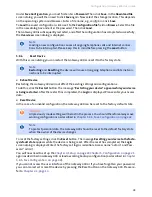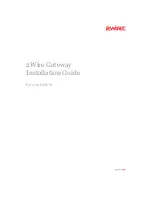
Gateway 400 User Guide | Legal Notices
50
7
Legal Notices
GNU General Public License
Some of the software used in ZyXEL products is subject to the so-called “GNU General Public License.” In accordance with the provi-
sions of this license, you can continue to use the software that we publish. Please note, however, that we do not assume any liability
or provide any warranty for the software released by us under the “GNU General Public License” according to the license terms.
You may copy and distribute verbatim copies of the Program’s source code as you receive it, in any medium, provided that you con-
spicuously and appropriately publish on each copy an appropriate copyright notice and disclaimer of warranty; keep intact all the no-
tices that refer to this License and to the absence of any warranty; and give any other recipients of the Program a copy of this License
along with the Program.
The GNU General Public License is available in a legally binding form in English on the Internet at
http://www.gnu.org/licenses/gpl.html
. The German translation can be viewed at
http://www.gnu.de/gpl-ger.html
.
If you want to receive the corresponding open source code covered by these licenses, please contact the Technical Support of ZyXEL
at
support@zyxel.de
.
The original text of the GNU General Public License is reproduced below.
GNU GENERAL PUBLIC LICENSE
Version 3, 29 June 2007
Copyright © 2007 Free Software Foundation, Inc. <http://fsf.org/ >
Everyone is permitted to copy and distribute verbatim copies of this license docu-
ment, but changing it is not allowed.
Preamble
The GNU General Public License is a free, copyleft license for software and other
kinds of works.
The licenses for most software and other practical works are designed to take
away your freedom to share and change the works. By contrast, the GNU General
Public License is intended to guarantee your freedom to share and change all ver-
sions of a program--to make sure it remains free software for all its users. We, the
Free Software Foundation, use the GNU General Public License for most of our
software; it applies also to any other work released this way by its authors. You
can apply it to your programs, too.
When we speak of free software, we are referring to freedom, not price. Our Gen-
eral Public Licenses are designed to make sure that you have the freedom to dis-
tribute copies of free software (and charge for them if you wish), that you receive
source code or can get it if you want it, that you can change the software or use
pieces of it in new free programs, and that you know you can do these things.
To protect your rights, we need to prevent others from denying you these rights or
asking you to surrender the rights. Therefore, you have certain responsibilities if
you distribute copies of the software, or if you modify it: responsibilities to respect
the freedom of others.
For example, if you distribute copies of such a program, whether gratis or for a fee,
you must pass on to the recipients the same freedoms that you received. You
must make sure that they, too, receive or can get the source code. And you must
show them these terms so they know their rights.
Developers that use the GNU GPL protect your rights with two steps: (1) assert
copyright on the software, and (2) offer you this License giving you legal permis-
sion to copy, distribute and/or modify it.
For the developers’ and authors’ protection, the GPL clearly explains that there is
no warranty for this free software. For both users’ and authors’ sake, the GPL re-
quires that modified versions be marked as changed, so that their problems will
not be attributed erroneously to authors of previous versions.
Some devices are designed to deny users access to install or run modified ver-
sions of the software inside them, although the manufacturer can do so. This is
fundamentally incompatible with the aim of protecting users’ freedom to change
the software. The systematic pattern of such abuse occurs in the area of products
for individuals to use, which is precisely where it is most unacceptable. Therefore,
we have designed this version of the GPL to prohibit the practice for those prod-
ucts. If such problems arise substantially in other domains, we stand ready to ex-
tend this provision to those domains in future versions of the GPL, as needed to
protect the freedom of users.
Finally, every program is threatened constantly by software patents. States should
not allow patents to restrict development and use of software on general-purpose
computers, but in those that do, we wish to avoid the special danger that patents
applied to a free program could make it effectively proprietary. To prevent this, the
GPL assures that patents cannot be used to render the program non-free.
The precise terms and conditions for copying, distribution and modification follow.
TERMS AND CONDITIONS
0. Definitions.
“This License” refers to version 3 of the GNU General Public License.
“Copyright” also means copyright-like laws that apply to other kinds of works, such
as semiconductor masks.
“The Program” refers to any copyrightable work licensed under this License. Each
licensee is addressed as “you”. “Licensees” and “recipients” may be individuals or
organizations.
To “modify” a work means to copy from or adapt all or part of the work in a fashion
requiring copyright permission, other than the making of an exact copy. The result-
ing work is called a “modified version” of the earlier work or a work “based on” the
earlier work.
A “covered work” means either the unmodified Program or a work based on the
Program.
To “propagate” a work means to do anything with it that, without permission, would
make you directly or secondarily liable for infringement under applicable copyright
law, except executing it on a computer or modifying a private copy. Propagation
includes copying, distribution (with or without modification), making available to
the public, and in some countries other activities as well.
To “convey” a work means any kind of propagation that enables other parties to
make or receive copies. Mere interaction with a user through a computer network,
with no transfer of a copy, is not conveying.
An interactive user interface displays “Appropriate Legal Notices” to the extent
that it includes a convenient and prominently visible feature that (1) displays an
appropriate copyright notice, and (2) tells the user that there is no warranty for the
work (except to the extent that warranties are provided), that licensees may con-
vey the work under this License, and how to view a copy of this License. If the in-
terface presents a list of user commands or options, such as a menu, a prominent
item in the list meets this criterion.
1. Source Code.
The “source code” for a work means the preferred form of the work for making
modifications to it. “Object code” means any non-source form of a work.
A “Standard Interface” means an interface that either is an official standard de-
fined by a recognized standards body, or, in the case of interfaces specified for a
particular programming language, one that is widely used among developers
working in that language.
The “System Libraries” of an executable work include anything, other than the
work as a whole, that (a) is included in the normal form of packaging a Major Com-
ponent, but which is not part of that Major Component, and (b) serves only to en-
able use of the work with that Major Component, or to implement a Standard
Interface for which an implementation is available to the public in source code
form. A “Major Component”, in this context, means a major essential component
(kernel, window system, and so on) of the specific operating system (if any) on
which the executable work runs, or a compiler used to produce the work, or an ob-
ject code interpreter used to run it.
The “Corresponding Source” for a work in object code form means all the source
code needed to generate, install, and (for an executable work) run the object code
and to modify the work, including scripts to control those activities. However, it
does not include the work’s System Libraries, or general-purpose tools or gener-
ally available free programs which are used unmodified in performing those activ-
ities but which are not part of the work. For example, Corresponding Source
includes interface definition files associated with source files for the work, and the
source code for shared libraries and dynamically linked subprograms that the
work is specifically designed to require, such as by intimate data communication
or control flow between those subprograms and other parts of the work.
The Corresponding Source need not include anything that users can regenerate
automatically from other parts of the Corresponding Source.
The Corresponding Source for a work in source code form is that same work.
Summary of Contents for 400
Page 1: ...User Guide Gateway 400 ...
Page 2: ......
Page 7: ...7 11 Index 65 ...
Page 8: ...8 ...
Page 54: ...Gateway 400 User Guide Legal Notices 54 ...
Page 58: ...Gateway 400 User Guide Passwords 58 Note More Notes ...
Page 67: ......
















































